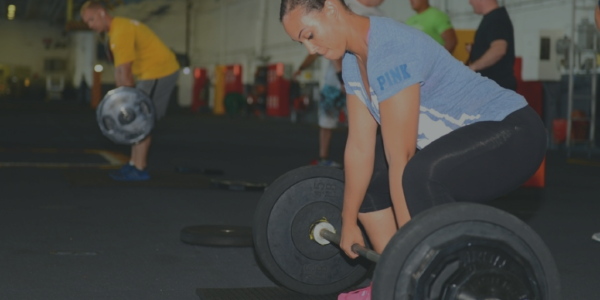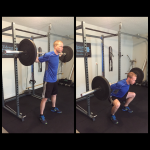Last year, I wrote an article for the local paper on how adding a finisher into your workouts can help speed up fat loss.
If you’re unfamiliar with what a finisher is, it’s an exercise or group of exercises performed at the end of your workout. They’re usually 10 minutes or less in length and performed at an extremely high intensity. They’re designed to push you beyond your limit and will test your mental toughness.
One of the primary benefits of using finishers is they increase our body’s ability to burn fat. As noted in my fat loss hierarchy article, the body exhibits homeostasis at rest. Basically, this is the regulatory mechanisms that keep us functioning throughout the day though our environment may be constantly changing.
When homeostasis is disrupted, our metabolism speeds up to get us back to that rested state. When metabolism increases, we burn more calories than normal. And this improves fat burning.
Finishers do an excellent job of disrupting our homeostatic balance, which is why they are a great tool to use if you want to melt fat and get lean. And with that in mind, I want to provide the top 5 workout finishers to include in your training programs that will help you do just that.
1. Interval
This one is basic, but also very effective. An interval utilizes an alternating work and rest period. You will perform the designated exercise in the work period and then take a break in the rest period.
Here are some examples:
10 seconds work – 50 seconds rest for 8-10 rounds
20 seconds work – 40 seconds rest for 6-8 rounds
30 seconds work – 30 seconds rest for 4-6 rounds
30 seconds work – 60 seconds rest for 6-8 rounds
You could do this with any exercise you choose, such as goblet squats or push ups. You could also do this on cardio equipment like the treadmill, bike, or rower.
For example, let’s say you are using the treadmill with a 30-30 work to rest ratio for 6 rounds. You’d sprint as fast as you could for 30 seconds then rest for 30 seconds. You’d repeat this cycle until all 6 rounds are complete.
2. Every Minute On The Minute (EMOM)
This one is similar to the interval with one slight difference: there are no specific work and rest times laid out. You simply set a rep number to hit on each set; then rest for the remainder of the minute after all reps are complete. Once a new minute begins, you will start the next work period.
I’ll give you an example with kettlebell swings. You could perform 6 sets of 15 reps.
You’d start the timer and perform your first set of 15. Let’s say this takes you 27 seconds to complete. You would then rest for 33 seconds. Then the 2nd minute would start and you’d perform your next set. This set takes 28 seconds to complete, so you now have 32 seconds of rest until the next set.
You’d continue performing each new set on each new minute until all sets are complete. Just like with the interval finisher, this can be done with any exercise or any piece of exercise equipment that you’d like.
3. Distance
This finisher is exactly what it sounds like. The goal is to complete a specified distance with each set. This type of finisher is best done with cardio based equipment like a treadmill or rower but can also be done with exercises that require you to be mobile like a bear crawl, walking lunge, or farmer’s carry.
For example, a cardio-based distance finisher may look like this:
.15 mile sprint on treadmill followed by 1 minute of rest for 5 rounds
or
200 meter row on a indoor rower followed by 45 seconds of rest for 6 rounds
A few examples of exercise-based distance finishers could be:
Bear crawl 40 yards followed by 45 seconds of rest for 5 rounds
or
Farmer’s Carry for 50 yards followed by 1 minute of rest for 7 rounds
All you have to do is set the distance, rest time, and the total number of rounds then get to work.
4. Ladder
This is a fun type of finisher because you compete against yourself to see how fast you can complete it. It typically utilizes 2 exercises where one or both of the exercise rep schemes are performed in a descending fashion. You complete each movement until all reps are done in the least amount of time possible.
There are a couple ways I like to set these up.
Method 1: Perform 1 exercise for a constant number of reps while the second exercise is set up in a descending order. Let’s say you are pairing a dumbbell front squat with a push up. It may look like this:
DB front squat: 4 reps
Push-up: 10-1 reps
So you would perform 4 reps on the front squat then 10 reps on the push up. Next, perform 4 reps on the front squat then 9 reps on the push up. Repeat this sequence until you have 0 reps left in the push up.
Method 2: Perform both exercises in a descending order. Using the same exercises as above, it could look like this:
DB front squat: 8-1 reps
Push-up: 8-1 reps
You’d perform 8 reps on the front squat and 8 reps on the push-up. Then 7 and 7. Then 6 and 6. Repeat until you have 0 reps left on both exercises.
This type of finisher is very fatiguing, so it’s important to pick exercises that you can do well when you’re tired. Trying to do this with a new exercise isn’t the best idea, because you’re bound to use sloppy form.
Like I mentioned a second ago, the goal is to complete it in the fastest time possible. Be sure to time yourself and try to beat your record each week.
5. Density Sets
I’ve written about density sets in the past, and how they are great to use when short on time. The goal of a density set is simple: complete as much work as possible in the allotted time.
A density set is usually made up of 2 non-competing exercises and performed for 4-5 minutes. By non-competing I mean, two exercises that don’t work the same muscle groups.
Just like with a ladder, this type of finisher is very tough. You won’t be able to work for 4-5 minutes straight if you pair two exercises together that hit the same muscle. For example, a reverse lunge and a goblet squat both hit the quads so it wouldn’t be a good idea to pair them together.
Having said that, there are several different ways you can set these up.
You could pair a lower body exercise with an upper body exercise. For example, a kettlebell swing and a push up. It would look like this:
Kettlebell swing: 12 reps
Push up: 8 reps
Perform as many rounds as possible in 5 minutes without rest.
Or you could pair a lower body exercise with a total body exercise. One of my favorites is a hip thrust with an inchworm. You’d set it up like this:
Hip thrust: 8 reps
Inchworm: 4 reps
Perform as many reps as possible in 4 minutes without rest.
You could also pair an upper body exercise like a inverted row with total body exercise like a bear crawl.
Inverted row: 8 reps
Bear crawl: 10 steps/side
Perform as many rounds as possible in 4 minutes without rest.
The important thing to remember with density sets is you don’t want to set the time too high. Keep them short and work as hard as you can. Record how many rounds you complete and try to increase it each week.
Wrapping Up
There you have it! Five different types of finishers you can add to your workouts to keep things fresh, fun, and intense. Not only will these finishers help you melt fat and get lean, they will challenge your ability to push yourself. Program any one of these into your workouts and you will undoubtedly see excellent results.






